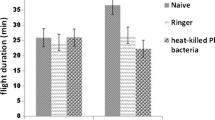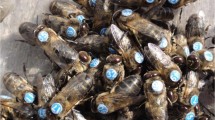Summary
The life span of worker-honeybees is determined by the duration of the hive-period and of the foraging period (Figs. 1,2). The duration of the forgaing period is regulated in the following way: Total flight performance of the individual bee seems to be fixed. Daily flight performance strongly affects total flight duration. High daily flight performance decreases maximal flight duration and vice versa.
Foragers accumulate the highest glycogen reserves in the flight muscles compared to other stages (Figs. 3, 4). They use these reserves to overcome starvation or when growing old. Young foragers are able to restore glycogen reserves after sugar intake, whereas old foragers were found to have a reduced glycogen synthesizing ability (Fig. 5).
The results indicate that bees exhaust their energysupplying mechanisms after a definite total flight performance.
Similar content being viewed by others
References
Adelman RC (1971) Age-dependent effects in enzyme induction — a biochemical expression of aging. Exp Gerontol 6:75–87
Bulos B, Shukla S, Sacktor B (1972) Bioenergetic properties of mitochondria from flight muscle of aging blowflies. Arch Biochem Biophys 149:461–469
Burcombe JV (1972) Changes in enzyme levels during ageing inDrosophila melanogaster. Mech Ageing Dev 1:213–225
Free JB, Spencer-Booth Y (1959) The longevity of worker honeybees. Proc R Entomol Soc (A) 34:10–12
Frisch K von (1923) Über die “Sprache” der Bienen, eine tierpsychologische Untersuchung. Zool Jahrb Abt Allg Zool Physiol 40:1–186
Jaycox ER, Skowronek W, Guynn G (1974) Behavioral changes in worker honeybees (Apis mellifica) induced by injections of a juvenile hormone mimic. Ann Entomol Soc Am 67:529–534
Jeffree EP, Allen MD (1957) The annual cycle of pollen storage by honeybees. J Econ Entomol 50:211–212
John M (1958) Über den Gesamtkohlenhydrat- und Glycogengehalt der Bienen. Z Vergl Physiol 41:204–220
Johnson BG, Rowley WA (1972) Ultrastructural changes inCulex tarsalis flight muscle associated with exhaustive flight. J Insect Physiol 18:2391–2399
Lindauer M (1952) Ein Beitrag zur Frage der Arbeitsteilung im Bienenstaat. Z Vergl Physiol 34:299–345
Lundie AE (1925) The flight activity of the honeybee. US Dep Agricult Bull 1328:1–37
Martin U, Martin H, Lindauer M (1978) Transplantation of a time-signal in honeybees. J Comp Physiol 124:193–201
Maurizio A (1950) Untersuchungen über den Einfluß der Pollennahrung und Brutpflege auf die Lebensdauer und den physiologischen Zustand der Bienen. Schweiz Bienenzg 73:58–65
Miquel J (1971) Aging of maleDrosophila melanogaster: Histological, histochemical and ultrastructural observations. Adv Gerontol Res 3:39–70
Nayar JK, Handel E van (1971) The fuel for sustained mosquito flight. J Insect Physiol 17:471–481
Ragland SS, Sohal RS (1975) Ambient temperature, physical activity and aging in the house fly,Musca domestica. Exp Gerontol 10:279–290
Rockstein M (1950) Glycogen metabolism in insects: a review. Bull Brooklyn Entomol Soc 45:74–81
Rockstein M (1972) The role of molecular genetic mechanisms in the aging process. In: Rockstein M, Baker GT III (eds) Molecular genetic mechanisms in development and aging. Academic Press, New York, pp 1–10
Roe JH, Dailey RE (1966) Determination of glycogen with the anthrone reagent. Anal Biochem 15:245–250
Rowley WA, Graham CL (1968) The effect of age on the flight performance of femaleAedes aegypti mosquitoes. J Insect Physiol 14:719–728
Rutz W, Imboden H, Jaycox ER, Wille H, Gerig L, Lüscher M (1977) Juvenile hormone and polyethism in adult worker honeybees (Apis mellifica). Proc 8th Int Congr IUSSI, Wageningen
Sachs L (1973) Angewandte Statistik. Springer, Berlin Heidelberg New York
Sacktor B (1970) Regulation of intermediary metabolism, with special reference to the control mechanisms in insect flight muscle. Adv Insect Physiol 7:267–347
Sohal RS (1976) Metabolic rate and life span. In: Cutler RG (ed) Cellular ageing, part I, vol 9, Interdisciplinary topics in gerontology. Karger, Basel, pp 25–40
Tribe MA (1967) Age related changes in the respiratory physiology of flight muscle tissues from the blowfly,Calliphora erythrocephala. Exp Gerontol 2:113–121
Tribe MA (1972) Biochemical and structural variations in the flight muscle mitochondria of ageing blowflies,Calliphora erythrocephala. J Cell Sci 10:443–469
Author information
Authors and Affiliations
Rights and permissions
About this article
Cite this article
Neukirch, A. Dependence of the life span of the honeybee (Apis mellifica) upon flight performance and energy consumption. J Comp Physiol B 146, 35–40 (1982). https://doi.org/10.1007/BF00688714
Accepted:
Issue Date:
DOI: https://doi.org/10.1007/BF00688714




